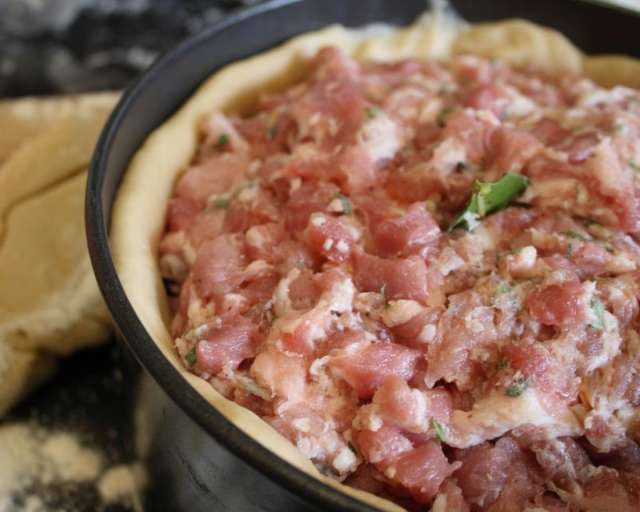I feel like I’ve mastered a mysterious, secret art.
I made a pork pie, and it was easy. More than that, it tasted astounding.
Here’s how.
Start with the pastry. The pastry is unusual as it’s made with hot water. It seems to go against everything you know about making pastry, but it does work.
Gently melt 100g of butter and 100g of lard together in a pan, with 200ml of water. While the fats are melting, mix 550g of plain flour and one and a half teaspoons of salt together in a large bowl, then break two eggs into the bowl. Using a knife to start with, cut the eggs into the flour a little and slowly pour in the fat and water, mixing all the time.
The dough will come together. You may need to add more flour or water. Briefly knead the dough, then wrap it in clingfilm and let it rest in the fridge for an hour or so.
Now the filling. The filling of a pork pie is basically a course pate, and it’s no more difficult than making a meatloaf or a decent burger.
Cut 1kg of pork shoulder into small cubes, about half a centimetre across, and place it in a large mixing bowl. A very sharp knife is vital here, as well as patience – it takes a while.
Add 250g of finely chopped salt pork, streaky bacon or, if you’re feeling extravagant and want a continental twist, pancetta to the bowl, along with 250g of minced belly pork. Your butcher will be able to mince a few slices of belly pork for you.
The balance of meats is important. The chunky shoulder adds texture, the bacon or salt pork adds flavour and the minced belly provides fat, to keep the pie moist.
Now to season the filling. Finely chop a dozen sage leaves and the leaves from two large sprigs of thyme and add them to the meat, along with a generous teaspoon of salt, a teaspoon of freshly ground black pepper, a teaspoon of ground white pepper, half a teaspoon of ground mace and a good pinch of cayenne pepper. Mix everything together well.
Next, cut off about a third of the pastry and put it to one side for the lid, then roll out the rest into a 30cm round. Slide the pastry into a 20cm cake tin with a loose base and press it down so that the pastry reaches about three quarters of the way up the side of the tin. Using a spring form tin with a clip on the side will make the ‘getting the pie out’ operation much simpler.
Fill the pastry case with the meat, and push a single bay leaf into the very centre of the pie.
Bake at 180c for thirty minutes, then reduce the heat to 160c and continue to cook for a further hour and a quarter.
After this time, take the pie out of it’s tin and brush the top and sides with beaten egg, returning it to the oven for another quarter of an hour to brown.
When the pie has finally finished cooking, let it stand for half an hour or so to cool, then heat up 250ml of pork stock that will set to a jelly in a pan. Making pork stock with a couple of trotters will guarantee that the stock will set, but if you’re unsure, add some gelatin as well.
Using a turkey baster, squirt the hot stock into the hole at the top of the pie. The meat will have shrunk during cooking, and there’ll be a gap between it and the crust, which you want to fill with jelly. This could take some time – let the stock sink into the pie before adding more – but try to get as much stock in as possible.
Leave the pie to cool completely, then refrigerate overnight to allow the jelly to set.
Serve huge wedges with a simple salad and some chutney for an easy, but substantial lunch.
The pie will keep for a couple of weeks in the fridge. It’s enormous – you’ll need a lot of people to eat it in one go. This is proper food.
This recipe is from Hugh Fearnley–Whittingstall’s unsurpassed The River Cottage Meat Book. All carnivores should own a copy.



